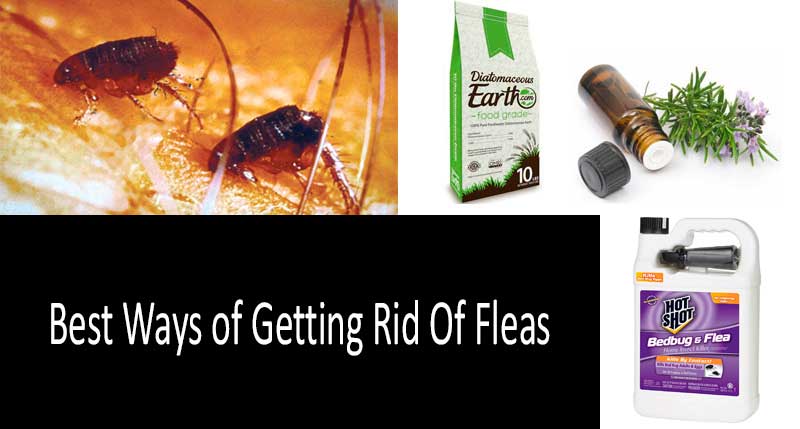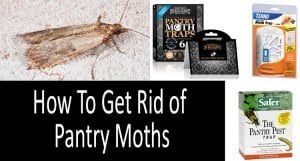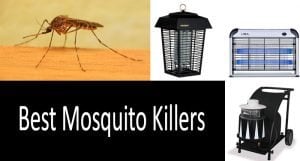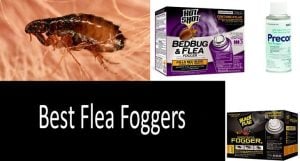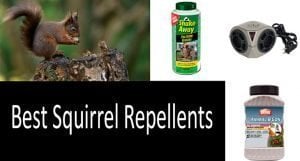If you’ve found yourself on this page, we hardly need to explain what fleas are. They are small, dark bugs excellent at jumping and painfully biting. Who deliver a lot of trouble for many people and their pets. Here, you’ll know how to get rid of fleas. There are different ways and products to get rid of fleas in a house and yard.
They won’t leave your house if you don’t drive them out, so you’ll have to take serious measures in order to get rid of fleas.
Well, we’re going to honestly warn you: You’ll need a lot of time and effort. But it is surely worth it. We’ll tell you how to get rid of fleas quickly, effectively, without expensive exterminators, and once and for all.
- 6 Compulsory Steps to Getting Rid of Fleas in Your House
- What is the Best Way to Get Rid of Fleas in the House: A comparison table
- How to Get Fleas Out of Carpet?
- How to Get Rid of Fleas in the Yard?
In order to eliminate them effectively, you have to know where fleas come from and thus, you’ll be able to identify the main reasons and sources of fleas in your house.
Where Do Fleas in the House Come From?
- Home pets (cats and dogs) bring fleas from the outside.
- Your street clothing and shoes (it’s far easier to bring some flea eggs along with the dirt on the soles of your shoes or clothing than you think).
- Neighbors’ fleas or bed bugs won’t have a hard time crawling to your house from their home.
- A basement or an attic can be infested with rats that have rat fleas. If fleas happily live and breed at your house, then it is possible that they have been there for a long time. For example, the previous owners of your house might not have completely eliminated them, or a colony of fleas in your backyard already existed, and has recently moved in to your house.
As you can see, fleas can appear absolutely everywhere, so you need to eliminate the causes of their possible appearance step-by-step. The most obvious step is to first make sure that your house is not infested with pests and that you do not need to get rid of rats. You should also check whether your neighbors have any fleas.

How to Get Rid of Fleas in the House: 6 Compulsory Steps
After that, you can start! Choose a day during the weekend and begin eliminating fleas. You have already understood that you’ll have to clean out all of the rooms, haven’t you? This is the first and most essential step when getting rid of house fleas. So, you’ll have to:
1. Wash your bed sheets, blankets, curtains, all of your pet’s bedding, toys, pillows and blankets. It’s even better to dry clean them. This measure will help identify not only fleas, but the bed bugs, which are more visible on the mattress and upholstery. Wash everything on your washing machines highest temperature (the higher, the better as the fleas are very tenacious).
2. Clean the carpets and furniture. Did you know that most often fleas bite your legs? That happens because most fleas live and breed in the carpets – which you walk over daily – and on the furniture where you sit, so you have to ensure they are always clean. Pay special attention to front door mats if you have any. Also, do not forget to vacuum the bathroom mat as well. Once you’ve finished, put the contents of the vacuum cleaner in a sealed plastic bag and throw it in the trash immediately, so that the nimble fleas won’t have time to come back. For better removal of fleas from the carpet, use diatomaceous earth, chemical insecticide sprays with IGR or concentrated IGRs. Repeat vacuum is required some time after such treatment.
3. Wash the floors. We hope that you do this regularly without our reminder but it is useful to repeat it again: Fleas scatter their eggs around, which is why the floors in the house also require frequent cleaning. Do not neglect the corners, skirting boards and the areas under cabinets and other furniture. When washing, you can also add clove or peppermint oil in the water. If possible, spread diatomaceous earth over the floor, in the corners and any cracks after washing or apply a natural spray.
Helpful tip: Fleas are put off by the smell of many aggressive chemicals and chemical compound products, such as glue, paint, cement and putty. So it might as well be a good time for carrying out some repair works!

4. Throw things away. If you find that your mattress is full of dirt, dead bugs and eggs of different origin, you’d better throw it in the trash, because you won’t be able to clean it properly by yourself. Of course, you can use a professional service for that, but trust us, you can get rid of fleas in the house on your own and buy a new mattress with the money saved. ☺
5. Wash your street shoes. As we have already mentioned, your street shoes can be a great “transporter” of flea eggs into your house. It is therefore necessary to wash everything you’ve lately worn outside in order to prevent further infestation.
6. Treat your pets. If fleas have infested your cat or dog, then your house will be permanently occupied by these insects until you kill them all. You can choose from a variety of means of controlling the fleas at your disposal, from auxiliary tools such as special combs and collars to powerful long-acting flea drops. Using the same products for cats and dogs can be dangerous for their health, so we have covered them separately in our following Guides:
After the complete clean-up, it’s high time to use some serious “weapons” such as home flea control products. The list of such items for killing fleas can be very long. The main types of such products are traps, sprays and bombs (foggers).
What is the best way to get rid of fleas in house? Comparative Table of the 13 Methods and Flea Control Products
In the majority of cases, fleas infest houses because of the pets that live there. That is why any treatment you begin at home or in your backyard must be accompanied by the treatment of your pet.
Efficiency Scale: 1 being the least, 10 being the most efficient.
| Area | Method | How Does It Work? | Features |
| Carpet, Floor and Furniture | Vacuum cleaning
Efficiency: 5 |
Removes fleas from the carpet at any development stage. | Will remove most adults, 30-60% of eggs and only 15-30% of larvae. |
| Homemade flea killers
Efficiency: 3 |
Can kill adult fleas on contact. | Unpleasant odor can remain. Kerosene-based killers may be dangerous. | |
| Natural powder – DE
Efficiency: 8 |
Dehydrates adult fleas to death. | The method is effective but messy, requires repeat use. | |
| Washing the floor and street shoes
Efficiency: 4 |
Removes eggs. | Requires thoroughness, repeat use and frequent mop change. | |
| Washing and drying bed sheets
Efficiency: 4 |
High temperature of 120 F kills adult species, larvae and eggs. | Does not reduce insect population significantly. | |
| Chemical sprays with IGR
Efficiency: 10 |
Remove adults on contact quickly and IGRs gradually destroy eggs and larvae. | The most effective home method. | |
| Concentrated IGR
Efficiency: 9 |
Slow action: block the development of eggs and larvae. | Are very effective, work best when combined with fast-acting insecticides. | |
| Natural sprays for home
Efficiency: 6 |
Can kill adult fleas on contact. | Best for in-house use, little effectiveness on animals. | |
| Rooms | Flea bombs
Efficiency: 3 |
Kill on contact only those insects that were attacked with poison. | Poisonous fog drops hardly reach inaccessible spots where fleas hide. |
| Flea traps
Efficiency: 3 |
They attract and trap adult insects. | Cannot fully eliminate house infestation, but are a good means of monitoring. | |
| Outdoors | Natural sprays for the yard
Efficiency: 6 |
Can kill adult fleas on contact. | Natural sprays are safe for outdoor use near pets, unlike permethrin-based ones. |
| Removing wild rodents (disease vectors)
Efficiency: 3 |
The fewer rats there are, the fewer chances that they will infest your house with fleas. | A preventive measure. | |
| Pet Treatment | Spot-on & systemic pet treatment
Efficiency: 9 |
This combination removes fleas at any development stage. | Additional house treatment is required. |
How to Get Fleas Out of Carpet?
Fleas prefer to live in carpets, where they can hide in the fur and where there are always someone’s delicious feet. If you take a magnifying glass, you’ll be able to see some adult species on brighter carpets and some scattered eggs and flea larvae on the darker ones. However, we do not recommend that you waste precious time and stare at the carpet with a magnifying glass, and instead we advise you to immediately begin eliminating the fleas. These insects multiply rapidly, so every day is at stake.
Clean the carpet with a vacuum cleaner. This is the first and most important step which will help to assess the problem and sometimes even eliminate most of the fleas’ eggs and larvae. After cleaning, dispose of the contents of the container in a thick plastic bag and throw it directly into the garbage outside. (Not in the garbage bin inside the home!)
Use natural or chemical flea carpet powder. You should then apply special flea control products. Various flea sprays and flea powders, both industrial and homemade liquid ones, are most suitable for exterminating the fleas in the carpet. Such products are:
Safer Brand Diatomaceous Earth – Natural Powder
This is a natural insecticide powder that is safe for humans and pets. According to the College of Agriculture and Life Sciences (Arizona), it is nevertheless fatal not only for fleas, but also for “anything with an exoskeleton. This means insects (anything with six legs) and non-insect arthropods (eight or more legs).”
 DE should be scattered on the carpet, which is quite messy as the air rises in a cloud of dust from the powder. In order to avoid this. you can use a special duster tool, such as Pest Pistol Mini Duster. The next day. you should vacuum the carpet and repeat the whole procedure until you completely exterminate the fleas. This much diatomaceous earth will be enough for treating the largest carpet or even a few of them.
DE should be scattered on the carpet, which is quite messy as the air rises in a cloud of dust from the powder. In order to avoid this. you can use a special duster tool, such as Pest Pistol Mini Duster. The next day. you should vacuum the carpet and repeat the whole procedure until you completely exterminate the fleas. This much diatomaceous earth will be enough for treating the largest carpet or even a few of them.
Price of Safer Brand DE (4 lb):< Check current price
Adams Carpet Powder – Chemical Powder
If the infestation is not large-scale, we have a decent option for Check current price. Adams Powder’s active ingredients are bio-insecticides linalool and pyrethrins and Nylar (IGR). Biological components will kill adult fleas and bed bugs on contact. However, they don’t have any residual action, and that is why this powder contains an IGR that will break the cycle of the eggs and larvae growing into adult biters. The manufacturer also promises that the powder will control re-infestation for up to 365 days.
 In general, the users are satisfied with this powder. One 16oz container treats 1-2 rooms, 200-400 square feet. Some of them had to buy a few containers to treat all the carpets, but it was definitely worth it. They recommend having a spare jar of Adams and treat animals along with the carpet. Otherwise, the fleas will stay at your place forever.
In general, the users are satisfied with this powder. One 16oz container treats 1-2 rooms, 200-400 square feet. Some of them had to buy a few containers to treat all the carpets, but it was definitely worth it. They recommend having a spare jar of Adams and treat animals along with the carpet. Otherwise, the fleas will stay at your place forever.
Price: (16 oz) Check current price
Use Concentrated IGR (Insect Growth Regulator). This is a rather powerful type of control product, which is supposed to be dissolved in a strict proportion in water and then sprayed on the carpet. Sometimes they come in the form of complete spray. As its name suggests, these types of sprays inhibit the multiplication of fleas, usually for several months.
 For example, the popular Precor IGR Insect Growth Regulator with methoprene is said to “kill flea eggs and larvae for 7 months,” i.e. until you wash the carpet with a shampoo or clean it with a steam generator. Note that it won’t be effective against adult fleas so use other measures to exterminate them. It costs: Check current price.
For example, the popular Precor IGR Insect Growth Regulator with methoprene is said to “kill flea eggs and larvae for 7 months,” i.e. until you wash the carpet with a shampoo or clean it with a steam generator. Note that it won’t be effective against adult fleas so use other measures to exterminate them. It costs: Check current price.
Use Killer Sprays with IGR. Such sprays kill adult insects when they come in contact with them and usually have a wide range of “victims,” including bed bugs, fleas, spiders, and others. They also ensure that adults lay eggs that will never hatch. We recommend using proven products such as methoprene-based Raid spray.
Raid Flea Killer Plus, Carpet & Room Spray
This Raid Spray is aimed at indoor treatment of carpets, upholstery and pets’ bedding. The aerosol has a wide spraying angle, allowing reach to even the least accessible places.
 The spray has a dual action and controls insects at all life stages. It contains an IGR (0,015% methoprene) which doesn’t let the eggs hatch into adult biters. However, IGR acts slowly which is why it is normally combined with fast-acting insecticides that kill adults and larvae.
The spray has a dual action and controls insects at all life stages. It contains an IGR (0,015% methoprene) which doesn’t let the eggs hatch into adult biters. However, IGR acts slowly which is why it is normally combined with fast-acting insecticides that kill adults and larvae.
The manufacturer promises that the product will protect you from fleas for four months. It seems like it’s true. Almost all of the customers who bought it were satisfied with its action. It looks like one bottle will cover one room. You need to abundantly spray all the contaminated surfaces and carpets, shut the door and leave the room. Some people complain of the spray’s strong smell but add that this inconvenience is a trifle in comparison with the results it yields.
Price: (2-pack) Check current price
Comparative Chart of 15 Best Flea Control Products for the House and Yard
Are Homemade Flea Killers Effective?
Long years of eliminating fleas bore a number of DIY treatments for carpet, house and yard. Most of such methods are quite cut-rate, but are they safe? Let’s find out what the scientists think about such homemade killers and their effectiveness.
{code 297}
Kerosene
Kerosene used to be one of the most popular yet dangerous control methods. It was first mentioned as an effective flea treatment back in 1935 in the Michigan State College of Agriculture and Applied Science bulletin: “Kerosene fortified with pyrethrum gives excellent results where it is possible to use kerosene without injury to the finish or where the odor is not objectionable.” Previously, such recipe was also used for killing bed bugs.
Modern carpet treatment recipe is as follows: dissolve 100 ml of kerosene in a bucket of water and spray this devilish mixture over carpet, leave the room and let it act. Some wet cleaning is recommended afterwards in order to remove any dead fleas from the carpet. FYI! Kerosene is flammable, so use safety gloves, don’t smell it and don’t smoke when you are near it!
Summer (Horticultural, Mineral) Oils
The scientists from Michigan recommend dissolving summer (horticultural) oil in water and nicotine sulphate in the same bulletin. The latter substance is considered to be extremely toxic nowadays so don’t follow this obsolete recommendation. However, summer oils are still effective against yard fleas. If you spray the ground and grass with dissolved oil, fleas will literally suffocate. Concentrated oil by Bonide is available on for: Check current price
Diatomaceous Earth
Scientists suggest that DE is a great natural flea insecticide for indoors. Experts from Penn State Extension explain that it “kills insects [fleas] through desiccation: they abrade the wax and oil on the insect’s outer covering, leading to dehydration and death.” Spray the dust over the carpet (you’d better use a powder duster) and leave for a few hours. Vacuum clean after.
FYI! Diatomaceous earth is only effective indoors with minimal moisture. That is why you should only treat dry carpets and not combine diatomaceous earth with sprays.
Borax, Boric Acid
The scientists approve of using borate products for killing parasites at home. Thus, the specialists from the Alabama A&M University and Auburn University state that “Work borate products registered for fleas, including boric acid and borax, into carpets as an effective treatment.”
FYI! “Boric acid may discolor some carpets, so be sure to test a small area first. Do not use these borate products outside around plants because boron compounds are non-selective herbicides.” Remember that borax powder is more harmful than the DE and thus it is not recommended to use it if there are children or pregnant women around.
If you still decide to use it, dissolve some borax in some warm water and treat the carpet with this solution. You can also use it as is, as you would use Diatomaceous Earth. Finish your work by vacuuming the carpet after a few hours.
Alcohol
This isn’t the most effective homemade treatment. The scientists never directly recommend cleaning the carpets with alcohol or its derivatives. However, many of them, including the Texas AgriLife Extension Service specialists, recommend using alcohol when combing fleas off the pets. “Dip the comb frequently in soapy water or an alcohol solution to kill any fleas removed from the pet.” We can conclude that alcohol is therefore capable of removing fleas, so you can mix some alcohol and water in a spray and spray the carpet just like you would do with other homemade treatments.
Baking Soda
Baking soda has been used as a fungicide for over 80 years, but it has poor insecticidal action. The scientists do not recommend using it. Despite this, the following homemade treatment is very popular: “Mix some salt and baking soda in an equal proportion (add about 2-3 tablespoons of each). Carefully rub it into the carpet, then leave for the night and vacuum it.” You can try it if you want.
Homemade Flea Repellents on Garlic and Brewer’s Yeast
The following homemade flea repellent recipes are popular online: Mix some brewer’s yeast and garlic mush and apply the mixture on the carpet. Give it some time to work, though – clean the carpet from organic residues and flea eggs a few hours later. But, according to the UC Davis School of Veterinary Medicine experts, this method is completely useless: “Electronic flea collars, brewer’s yeast, garlic, vitamin B tablets, and extracts of eucalyptus or pennyroyal, are not flea repellent.”
Conclusion: Not all homemade recipes are equally effective and safe. It’s up to you to decide whether you should use them.

Final tip: If you see that you have tried everything, and that there is no salvation for your carpet as the fleas continue to inhabit it, roll it up tightly and throw it in the garbage. It’s better to buy a new one rather than waste your time and effort on trying to revive the old one.
How to Get Rid of Fleas on Humans?
We come across this question so often that we’ve finally decided to answer it. Fleas do not live on humans. Humans have lice or other insects. It would be more correct to say that a human can be subject to flea bites, but fleas do not inhabit their victims (be it a person, a cat or a dog) constantly. They get enough blood after the bite and then they jump off. The life cycle of the flea does not involve its constant dwelling on the body of the victim, and their larvae develop outside the warm-blooded body as the insects usually lay their eggs at a high speed everywhere around themselves.
So you should get rid of fleas on cat or dog and around your house.
Remember that the flea bites are an important signal of the future increase of fleas at your place, because according to the National Park Service US, “Females deposit eggs in groups of 1 to 18 on the host after a blood meal.” That’s why you shouldn’t neglect the issue and proceed to exterminating the fleas immediately after the first bite.

If you decide that you have been bitten by fleas, you should ensure that it was them and not mosquitoes or bed bugs, and then consider proper treatment of bites. Our review “Flea Bites on Humans: How to Identify and Treat” will help you cope with this task.
{code 297}
How to Get Rid of Fleas in the Yard?
As we have mentioned earlier, house fleas may appear if they have already settled in your backyard. As you know, dealing with nature is more difficult than controlling your own personal “climate” in the house, but is still possible. Your primary goal is to destroy fleas outside so that neither you nor your pets could accidentally bring them home.
So, in order to get rid of fleas in the yard, you need to be persistent:
- First, get rid of rats outside, if you have any. Rats are carriers of rat fleas that tend to settle first in the yard and then in the house.
- Regularly wash your porch and front stairs. You can also spray your front door with citronella oil or rosemary.
- Clean your dog and cat’s litter outdoors as often as possible.
- Make your own handmade flea traps for the yard. To do this, you will need a round bowl, some soap (or dishwashing detergent) and some water. Pour soapy water in the bowl and put it in a place inhabited by fleas. They will get trapped and drown. Replace these traps every day so that the mosquitoes won’t breed in this standing water.
- Use special flea killer sprays for lawns, trees, shrubs, flowers and outdoor surfaces, but make sure you carefully examine the active components they contain.
Cats are generally sensitive to pyrethroids and permethrins. According to the BBC, they can even die if permethrin-based products designed for the dogs are applied on them. That’s why we do not recommend using such sprays inside the house, on the porch or in the yard, if you have a cat.
It’s better to use natural oil-based sprays such a Vet’s Best Yard and Kennel Spray that contain clove oil extract and peppermint oil. It kills fleas on contact. Vet’s is a good option for using next to cats and dogs. It would be particularly useful when you have a lot of pets at home that spend time on the street and you do not want to get fleas in your house again after their treatment. The price of it is: Check current price.
It is important to take a complex approach to the issue of getting rid of fleas in the yard, because a single measure won’t be able to solve the problem. Fleas multiply rapidly and won’t leave your house and yard until you eliminate them.
How to Get Rid of Fleas Naturally
Organic methods of getting rid of fleas have been used for over 100 years. Many of them are effective enough to compete with industrial chemicals and are suitable for getting rid of the insects both indoors and outdoors. Here are some of these treatments:
- Extreme cold/heat – Fleas like moderate warmth, and extreme temperature fluctuations are lethal for them. Therefore, it is important to wash everything that is contaminated at a temperature of 120 degrees F and over, and, if possible, to take out the carpet/furniture/mattress and leave them under the sunlight. Cold can be used similarly: If the outside temperature is below 30 F, take everything you need outside and let the nature do its job.
- Wormwood – This plant has been regarded as a powerful insect repellent for many years. You can plant it in your backyard or simply sprinkle it generously on the floor and carpets in the house. Its smell is truly bitter, but many people actually like it.
- Lemon juice can be mixed with water (cut a single lemon and mix it with 0.5 liters of water) and spray this cocktail on furniture, floors and any other surface. It can kill fleas on contact but has no residual action.
- Essential oils of citronella, rosemary, tea tree, mint and citrus fruit – Many insecticides contain these oils as they can also kill fleas on contact. But do not use them indoors, as the excessive concentration of these oils in the air can trigger headaches, and some of the oils, such as tea tree oil are dangerous for cats.

Flea Control Tips: How to Prevent Flea Infestation
It is easier to prevent flea infestation than to get rid of these blood-sucking insects. Preventive methods are fairly simple and only demand that you have the following qualities:
- Cleanliness:
1. Clean your house more often, vacuum the carpets, floors and furniture, maintain clean porch.
2. Do not enter the house while wearing dirty shoes, wash your last season shoes and do not store them dirty.
3. Wash your pets’ paws and inspect their fur after taking them for a walk. Replace their flea collars regularly.
- Foresight:
1. Don’t pat street animals; they might share some of their fleas with you.
2. Don’t visit dirty, desolated places as you can also bring fleas’ eggs or adult species from there.
3. When camping, make sure you wear long-sleeved shirts and long pants in order to avoid getting flea bites on your legs and ankles (fleas rarely bite the upper body since they can’t reach it). Use repellents which have a high concentration of DEET, such as Repel 100 Insect Repellent Pump Spray (Check current price).
4. Control the rodents and bats in the house, as they are potential flea carriers.
5. Be wary of the things and furniture bought at garage sales, fairs and second-hand markets, as they can be infested with fleas.
6. Mow your lawn and take care of the garden. Plant some natural repellents, such as garlic, citronella, lemongrass, tansy, tarragon and thus reduce the likelihood of fleas’ appearance in your backyard.
7. If your neighbors have flea infestation, don’t waste any time and begin using such safe products as Diatomaceous Earth for protecting your house in order to prevent a sudden invasion of these nasty insects.
As you can see, you can get rid of fleas on your own, without an exterminator if you know some basic elimination methods and a couple of tricks. Be persistent and the fleas won’t have a choice but to leave your house forever.
Also read: Top-12 Flea Killers: Sprays, Traps, Foggers
{code 424}
{code 91}

